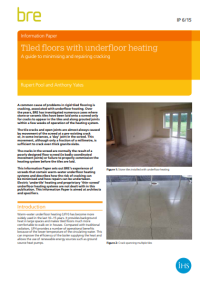Tiled floors with underfloor heating: A guide to minimising and repairing cracking
BRE (Building Research Establishment) is an independent, research-based consultancy, testing and training organisation, operating in the built environment and associated industries.
On 22 May 2015, BRE published Tiled floors with underfloor heating: A guide to minimising and repairing cracking (IP 6/15), by Rupert Pool and Tony Yates.
Warm-water underfloor heating (UFH) has become more widely used in the last 10–15 years. It provides background heat in large spaces and makes tiled floors much more comfortable to walk on in houses. Compared with traditional radiators, UFH provides a number of operational benefits because of the lower temperature of the circulating water. This can improve the efficiency of the boiler supplying the heat and allows the use of renewable energy sources such as ground source heat pumps.
However, cracking, associated with underfloor heating is a common cause of problems in rigid tiled flooring. BRE has investigated many cases where stone or ceramic tiles have been laid on screed only for cracks to appear in the tiles and along grouted joints within weeks of the heating system being operated. This is almost always caused by movement of the screed at a pre-existing crack or, in some instances, a ‘day’ joint in the screed. Even though this movement is just a fraction of a millimetre, it is sufficient to crack thick granite slabs. These cracks are normally the result of a poorly-designed floor screed (ie badly coordinated movement joints) or failure to properly commission the heating system before the tiles are laid.
This 8-page information paper sets out BRE’s experience of screeds that contain warm-water underfloor heating systems and describes how the risk of cracking can be minimised and how repairs can be undertaken. It is intended for architects and specifiers.
Its contents are:
- Introduction.
- Description of underfloor heating systems.
- Screed.
- Design of screed to incorporate underfloor heating.
- Problems that can occur.
- Crack-isolation systems.
- Commissioning the heating system.
- Checking a screed before the tiles are laid.
- Conclusions.
- References.
- Further reading.
Electric ‘undertile’ heating and proprietary ‘thin-screed’ underfloor heating systems are not dealt with.
[edit] Find out more.
[edit] Related articles on Designing Buildings Wiki
Featured articles and news
A change to adoptive architecture
Effects of global weather warming on architectural detailing, material choice and human interaction.
How big is the problem and what can we do to mitigate the effects?
Overheating guidance and tools for building designers
A number of cool guides to help with the heat.
The UK's Modern Industrial Strategy: A 10 year plan
Previous consultation criticism, current key elements and general support with some persisting reservations.
Building Safety Regulator reforms
New roles, new staff and a new fast track service pave the way for a single construction regulator.
Architectural Technologist CPDs and Communications
CIAT CPD… and how you can do it!
Cooling centres and cool spaces
Managing extreme heat in cities by directing the public to places for heat stress relief and water sources.
Winter gardens: A brief history and warm variations
Extending the season with glass in different forms and terms.
Restoring Great Yarmouth's Winter Gardens
Transforming one of the least sustainable constructions imaginable.
Construction Skills Mission Board launch sector drive
Newly formed government and industry collaboration set strategy for recruiting an additional 100,000 construction workers a year.
New Architects Code comes into effect in September 2025
ARB Architects Code of Conduct and Practice available with ongoing consultation regarding guidance.
Welsh Skills Body (Medr) launches ambitious plan
The new skills body brings together funding and regulation of tertiary education and research for the devolved nation.
Paul Gandy FCIOB announced as next CIOB President
Former Tilbury Douglas CEO takes helm.
UK Infrastructure: A 10 Year Strategy. In brief with reactions
With the National Infrastructure and Service Transformation Authority (NISTA).
Ebenezer Howard: inventor of the garden city. Book review.
Airtightness Topic Guide BSRIA TG 27/2025
Explaining the basics of airtightness, what it is, why it's important, when it's required and how it's carried out.























